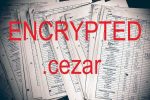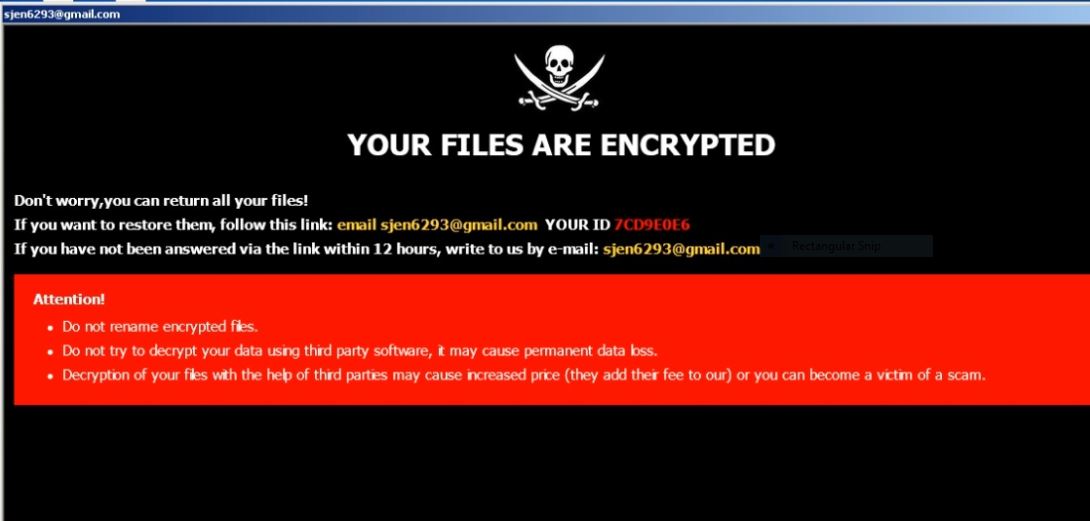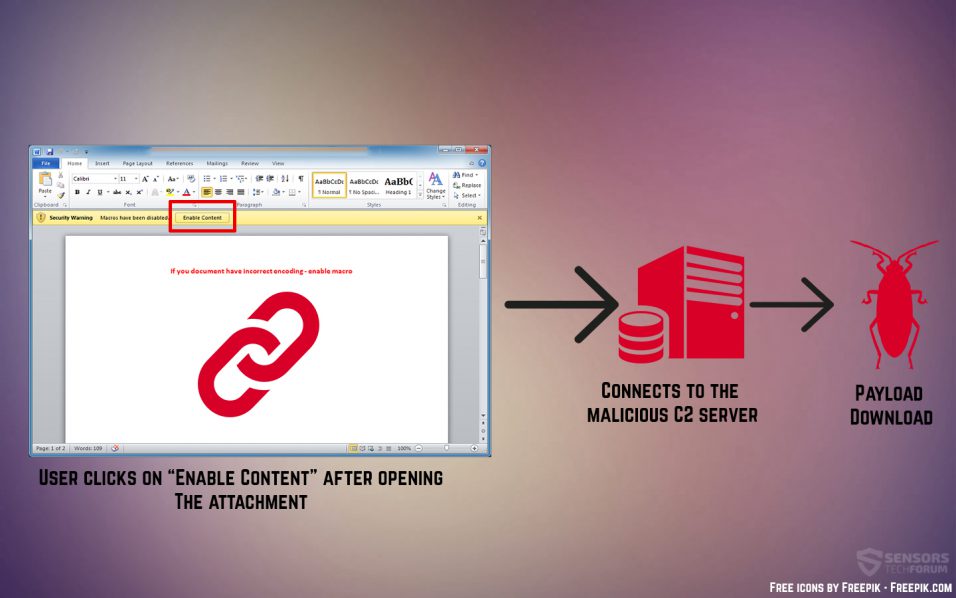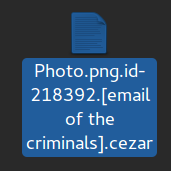 This article aims to help you remove the newly emerged variant of Dharma ransomware from your computer and shows how to restore files encrypted with the .cezar file extension added to them.
This article aims to help you remove the newly emerged variant of Dharma ransomware from your computer and shows how to restore files encrypted with the .cezar file extension added to them.
Dharma ransomware has been reportedly brought back up to life and this time it may be operated by more sophisticated cyber-criminal group. The new Dharma virus uses the .cezar file extension, which it adds to your important documents, photos, videos and other types of files once it encrypts them. The virus then drops a ransom note in which Dharma ransomware demands you to make a so-called ransom payoff to the cyber-criminals in BitCoin. Once that has been done, they promise to get the files decrypted once more. Experts strongly recommend not to pay the ransom and use other alternatives if you have become a victim of this virus. In the event that your files have been encrypted by with the .cezar file extension added to them, we strongly advise you to read this article thoroughly and learn how to remove this virus plus restore as much files as you can without having to pay the ransom.

Threat Summary
| Name | .cezar Dharma Virus |
| Type | Ransomware Infection |
| Short Description | Attacks your computer and holds your files hostage for a ransom by encrypting them with a powerful cipher. |
| Symptoms | After infection, all of the files become appended with the .cezar file extension added to them. |
| Distribution Method | Spam Emails, Email Attachments, Executable files |
| Detection Tool |
See If Your System Has Been Affected by malware
Download
Malware Removal Tool
|
User Experience | Join Our Forum to Discuss .cezar Dharma Virus. |
| Data Recovery Tool | Windows Data Recovery by Stellar Phoenix Notice! This product scans your drive sectors to recover lost files and it may not recover 100% of the encrypted files, but only few of them, depending on the situation and whether or not you have reformatted your drive. |
.Cezar Virus (Dharma Ransomware) February 2020 Attack Campaigns
A new attack campaign featuring the .cezar Dharma virus infection has been spotted in Italy. It is probably run by a different hacking group as the campaign is directed against visitors from this country. What we know for sure is that the likely source of infections are malware-infected documents that include dangerous Visual Basic Scripts (VBS). A common tactic is to create files that are of the most popular document types used by regular end users — text files, presentations, databases and spreadsheets. They can also be placed in ZIP archive files and send to the intended victims via phishing email messages or posted on hacker-controlled sites. In some cases the VBS scripts can automatically even by opening the malware-infected script.
The security analysis shows that the .Cezar virus does contain advanced functionality. The captured samples have been found to contain modules such as the following:
- Network Trojan Operations — Some of the virus samples have been found to contain the functionality to allow the remote attackers to spy on the victims, take over their computers and hijack their data.
- Memory Hookups — The main engine can be used to hijack the user actions and input in already running applications. This can lead to the harvesting of sensitive information as it is filled by the users.
- Information Gathering — The .Cezar virus can be programmed to acquire sensitive information about the victims and/or their machines.
In some cases the infections can be used to deploy other infections including ones that are part of the STOP ransomware family.
The rest of the actions that are part of the sequence will probably start the relevant encryption process — it will target certain user data and make it inaccessible. A strong cipher will be used and the data will be marked with the relevant extension. A ransom note or lockscreen will be generated to blackmail the users into paying.
.cezar Ransowmare – Update September 2017
The .cezar ransomware has been reported to use a specific way of infecting victims. That happens via the Necurs botnet with malspam in the same way that the other variant of Dharma (.cesar Files Virus) does. The Necurs botnet sends an e-mail with an attachment – usually an archive, accompanied by a short message or lack thereof. If a message is present, the email’s contents will show the reason for the mail is a legitimate receipt, invoice or another file that you should open. Opening the file eventually infects your computer with the .cezar ransomware virus.
How Does .cezar Ransowmare Infect?
The .cezar file extension variant of Dharma is not that different in comparison to other Dharma ransomware variants in terms of how it infects a given computer. As before, the methods are more than one and they may have even increased in number since malware researchers report that this ransomware virus has been uploaded as a RaaS (ransomware-as-a-service) in the deep web marketplaces. This essentially means that anyone can spread it, as long as they pay for it and the cyber-criminals take a huge percentage of the ransom paid, kind of like an affiliate scheme. This essentially means that all possible programs can be used to cause an infection with Dharma ransomware. The most widely known infection files that may be associated with this file encryption virus are believed to be the following:
- File Joiners to combine the malcious files of Dharma with legitimate documents, like Microsoft Word or .PDF files.
- Obfuscation software that conceals the actual malicious files of Dharma from conventional and unpatched security software.
- Malware droppers that pretend to be legitimate files, but actually may extract the malicious payload of the malware.
- Trojan.downloaders that connect to a malicious host from which they secretly download the payload of Dharma ransomware on your computer.
- Spamming websites or spamming services that help spread malicious comments on forums, e-mails and other deceitful online content in order to increase the infection rate.
- Online hosts which keep the malware uploaded and ready to be downloaded on the victim’s computer. These are changed a lot, since they are often blocked.
All of these tools together may result in different methods by which the cyber-criminals who have the task of infecting your computer with Dharma ransomware to spread it via different methods.
The primary of those methods is the most effective and most often used one – e-mail spam. Such messages may often pretend that the attachment they have is legitimate and important, like an invoice, a receipt or a letter of importance. If the file is malicious executable it causes the infection on your computer directly, but since those files have become easier to be spotter, cyber-criminals have the tendency to spread Microsoft Word documents carrying malicious macros. Such documents, like the example below can trigger infection with Dharma .cezar ransomware if you click on the “Enable Content” button.
Besides via macros and e-mail, other infection methods can also exist. The malicious files of Dharma .cezar variant can be uploaded on torrent websites or other suspicious sites as:
- Fake setups.
- Key generators.
- Game cracks.
- Files pretending to be photos, documents, programs, etc.
.cezar Dharma Ransomware – Malicious Activity
After an infection with Dharma’s .cezar file variant has been triggered, the ransomware may drop files on your computer that contain different names, for example:
→ {random alpha-numerical name}
{a name of a program that has spelling mistakes, for example pecman instead of pacman}
notepad.exe
svchost.exe
setup.exe
patch.exe
update.exe
software-update.exe
The files are generally hidden from plain side as they may reside in suspiciously named folders that may be created in the following Windows directories:
- %AppData%
- %Temp%
- %Roaming%
- %Common%
- %system32%
- %Local%
- %LocalLow%
When dropped, the malicious files of Dharma .cezar ransomware are also executed automatically, which results In multiple malicious processes being active on the victim’s computer. These processes ensure that Dharma ransowmare assumes control over your computer and your files. They can be detected briefly in Windows Task Manager during the infection process.
As soon as Dharma ransomware has been triggered, the virus may modify your Windows Registry Editor, more specifically attack the Run and RunOnce registry sub-keys, in which Dharma .cezar ransomware will add custom value strings that aim to make it’s files run on Windows boot. The keys have the following locations:
→ HKEY_CURRENT_USER\Software\Microsoft\Windows\CurrentVersion\
HKEY_LOCAL_MACHINE\Software\Microsoft\Windows\CurrentVersion\
Among the malicious acitivty of Dharma ransomware may be to delete the Shadow Volume copies of your computer. These are the backed up files from the VSS (Volume Shadow Service) on your computer. To delete them, .cezar ransomware may execute a batch file that inserts the vssadmin command in quiet mode, meaning that you do not see it while it is executed. The command is as follows:
→ vssadmin delete shadows /for={volume} /oldest /all /shadow={ID of the Shadow} /quiet
How Does Dharma .cezar Ransomware Encrypt Files
The process of encryption of Dharma Ransomware’s .cezar file variant Is no different than it’s previous versions. The virus may attack the important files on your computer, while it skips encrypting files in Windows system folders in order to ensure that your operating system works after the encryption. Among the files which the .cezar Dharma virus may render no longer to be able to be opened may are likely:
- Adobe .PDF files.
- Microsoft Office file formats.
- Virtual drive files (Virtual Box, etc.)
- Image files (photos, photoshop files, etc.)
- Audio files.
- Videos.
If files of such types are detected by the Dharma .cezar ransomware, the virus may begin to immediately perform various different types of modification on the files, likely using the AES (Advanced Encryption Standard) algorithm. The usage of this encryption is on the original structure code of the files and it replaces a part of this structure with the encrypted code. This results in the files becoming no longer openable with any type of program. The Dharma virus then adds the .cezar file extension to the files, making them look like the following:
After the encryption process has completed, the .cezar file ransomware may use a brief ransom note, which may look somewhat like the following:
“To decrypt files, write to my email {e-mail of the criminal}”

Remove Dharma Ransomware and Restore .cezar Encrypted Files
For the removal of this version of Dharma ransomware, we recommend that you take advantage of the instructions we have suggested below. We strongly suggest if you are not an advanced user to focus on the automatic removal instructions instead of manual removal below. Also, according to security experts, the best method to remove Dharma ransomware is to use an advanced anti-malware software which aims to make sure that all of the files and related registry objects to this virus are permanently erased from your computer and that it is protected against future threats as well.
If you want to restore files that have been encrypted by this ransomware on your computer, we have suggested multiple alternative methods for file recovery below in step “2. Restore files encrypted by .cezar Ransowmare” . They may not be 100% effective but their goal is to help you restore as many files as you possibly can without having to pay the ransom.
- Step 1
- Step 2
- Step 3
- Step 4
- Step 5
Step 1: Scan for .cezar Dharma Virus with SpyHunter Anti-Malware Tool



Ransomware Automatic Removal - Video Guide
Step 2: Uninstall .cezar Dharma Virus and related malware from Windows
Here is a method in few easy steps that should be able to uninstall most programs. No matter if you are using Windows 10, 8, 7, Vista or XP, those steps will get the job done. Dragging the program or its folder to the recycle bin can be a very bad decision. If you do that, bits and pieces of the program are left behind, and that can lead to unstable work of your PC, errors with the file type associations and other unpleasant activities. The proper way to get a program off your computer is to Uninstall it. To do that:


 Follow the instructions above and you will successfully delete most unwanted and malicious programs.
Follow the instructions above and you will successfully delete most unwanted and malicious programs.
Step 3: Clean any registries, created by .cezar Dharma Virus on your computer.
The usually targeted registries of Windows machines are the following:
- HKEY_LOCAL_MACHINE\Software\Microsoft\Windows\CurrentVersion\Run
- HKEY_CURRENT_USER\Software\Microsoft\Windows\CurrentVersion\Run
- HKEY_LOCAL_MACHINE\Software\Microsoft\Windows\CurrentVersion\RunOnce
- HKEY_CURRENT_USER\Software\Microsoft\Windows\CurrentVersion\RunOnce
You can access them by opening the Windows registry editor and deleting any values, created by .cezar Dharma Virus there. This can happen by following the steps underneath:


 Tip: To find a virus-created value, you can right-click on it and click "Modify" to see which file it is set to run. If this is the virus file location, remove the value.
Tip: To find a virus-created value, you can right-click on it and click "Modify" to see which file it is set to run. If this is the virus file location, remove the value.
Before starting "Step 4", please boot back into Normal mode, in case you are currently in Safe Mode.
This will enable you to install and use SpyHunter 5 successfully.
Step 4: Boot Your PC In Safe Mode to isolate and remove .cezar Dharma Virus





Step 5: Try to Restore Files Encrypted by .cezar Dharma Virus.
Method 1: Use STOP Decrypter by Emsisoft.
Not all variants of this ransomware can be decrypted for free, but we have added the decryptor used by researchers that is often updated with the variants which become eventually decrypted. You can try and decrypt your files using the instructions below, but if they do not work, then unfortunately your variant of the ransomware virus is not decryptable.
Follow the instructions below to use the Emsisoft decrypter and decrypt your files for free. You can download the Emsisoft decryption tool linked here and then follow the steps provided below:
1 Right-click on the decrypter and click on Run as Administrator as shown below:

2. Agree with the license terms:

3. Click on "Add Folder" and then add the folders where you want files decrypted as shown underneath:

4. Click on "Decrypt" and wait for your files to be decoded.

Note: Credit for the decryptor goes to Emsisoft researchers who have made the breakthrough with this virus.
Method 2: Use data recovery software
Ransomware infections and .cezar Dharma Virus aim to encrypt your files using an encryption algorithm which may be very difficult to decrypt. This is why we have suggested a data recovery method that may help you go around direct decryption and try to restore your files. Bear in mind that this method may not be 100% effective but may also help you a little or a lot in different situations.
Simply click on the link and on the website menus on the top, choose Data Recovery - Data Recovery Wizard for Windows or Mac (depending on your OS), and then download and run the tool.
.cezar Dharma Virus-FAQ
What is .cezar Dharma Virus Ransomware?
.cezar Dharma Virus is a ransomware infection - the malicious software that enters your computer silently and blocks either access to the computer itself or encrypt your files.
Many ransomware viruses use sophisticated encryption algorithms to make your files inaccessible. The goal of ransomware infections is to demand that you pay a ransom payment to get access to your files back.
What Does .cezar Dharma Virus Ransomware Do?
Ransomware in general is a malicious software that is designed to block access to your computer or files until a ransom is paid.
Ransomware viruses can also damage your system, corrupt data and delete files, resulting in the permanent loss of important files.
How Does .cezar Dharma Virus Infect?
Via several ways..cezar Dharma Virus Ransomware infects computers by being sent via phishing emails, containing virus attachment. This attachment is usually masked as an important document, like an invoice, bank document or even a plane ticket and it looks very convincing to users.
Another way you may become a victim of .cezar Dharma Virus is if you download a fake installer, crack or patch from a low reputation website or if you click on a virus link. Many users report getting a ransomware infection by downloading torrents.
How to Open ..cezar Dharma Virus files?
You can't without a decryptor. At this point, the ..cezar Dharma Virus files are encrypted. You can only open them once they are decrypted using a specific decryption key for the particular algorithm.
What to Do If a Decryptor Does Not Work?
Do not panic, and backup the files. If a decryptor did not decrypt your ..cezar Dharma Virus files successfully, then do not despair, because this virus is still new.
Can I Restore "..cezar Dharma Virus" Files?
Yes, sometimes files can be restored. We have suggested several file recovery methods that could work if you want to restore ..cezar Dharma Virus files.
These methods are in no way 100% guaranteed that you will be able to get your files back. But if you have a backup, your chances of success are much greater.
How To Get Rid of .cezar Dharma Virus Virus?
The safest way and the most efficient one for the removal of this ransomware infection is the use a professional anti-malware program.
It will scan for and locate .cezar Dharma Virus ransomware and then remove it without causing any additional harm to your important ..cezar Dharma Virus files.
Can I Report Ransomware to Authorities?
In case your computer got infected with a ransomware infection, you can report it to the local Police departments. It can help authorities worldwide track and determine the perpetrators behind the virus that has infected your computer.
Below, we have prepared a list with government websites, where you can file a report in case you are a victim of a cybercrime:
Cyber-security authorities, responsible for handling ransomware attack reports in different regions all over the world:
Germany - Offizielles Portal der deutschen Polizei
United States - IC3 Internet Crime Complaint Centre
United Kingdom - Action Fraud Police
France - Ministère de l'Intérieur
Italy - Polizia Di Stato
Spain - Policía Nacional
Netherlands - Politie
Poland - Policja
Portugal - Polícia Judiciária
Greece - Cyber Crime Unit (Hellenic Police)
India - Mumbai Police - CyberCrime Investigation Cell
Australia - Australian High Tech Crime Center
Reports may be responded to in different timeframes, depending on your local authorities.
Can You Stop Ransomware from Encrypting Your Files?
Yes, you can prevent ransomware. The best way to do this is to ensure your computer system is updated with the latest security patches, use a reputable anti-malware program and firewall, backup your important files frequently, and avoid clicking on malicious links or downloading unknown files.
Can .cezar Dharma Virus Ransomware Steal Your Data?
Yes, in most cases ransomware will steal your information. It is a form of malware that steals data from a user's computer, encrypts it, and then demands a ransom in order to decrypt it.
In many cases, the malware authors or attackers will threaten to delete the data or publish it online unless the ransom is paid.
Can Ransomware Infect WiFi?
Yes, ransomware can infect WiFi networks, as malicious actors can use it to gain control of the network, steal confidential data, and lock out users. If a ransomware attack is successful, it could lead to a loss of service and/or data, and in some cases, financial losses.
Should I Pay Ransomware?
No, you should not pay ransomware extortionists. Paying them only encourages criminals and does not guarantee that the files or data will be restored. The better approach is to have a secure backup of important data and be vigilant about security in the first place.
What Happens If I Don't Pay Ransom?
If you don't pay the ransom, the hackers may still have access to your computer, data, or files and may continue to threaten to expose or delete them, or even use them to commit cybercrimes. In some cases, they may even continue to demand additional ransom payments.
Can a Ransomware Attack Be Detected?
Yes, ransomware can be detected. Anti-malware software and other advanced security tools can detect ransomware and alert the user when it is present on a machine.
It is important to stay up-to-date on the latest security measures and to keep security software updated to ensure ransomware can be detected and prevented.
Do Ransomware Criminals Get Caught?
Yes, ransomware criminals do get caught. Law enforcement agencies, such as the FBI, Interpol and others have been successful in tracking down and prosecuting ransomware criminals in the US and other countries. As ransomware threats continue to increase, so does the enforcement activity.
About the .cezar Dharma Virus Research
The content we publish on SensorsTechForum.com, this .cezar Dharma Virus how-to removal guide included, is the outcome of extensive research, hard work and our team’s devotion to help you remove the specific malware and restore your encrypted files.
How did we conduct the research on this ransomware?
Our research is based on an independent investigation. We are in contact with independent security researchers, and as such, we receive daily updates on the latest malware and ransomware definitions.
Furthermore, the research behind the .cezar Dharma Virus ransomware threat is backed with VirusTotal and the NoMoreRansom project.
To better understand the ransomware threat, please refer to the following articles which provide knowledgeable details.
As a site that has been dedicated to providing free removal instructions for ransomware and malware since 2014, SensorsTechForum’s recommendation is to only pay attention to trustworthy sources.
How to recognize trustworthy sources:
- Always check "About Us" web page.
- Profile of the content creator.
- Make sure that real people are behind the site and not fake names and profiles.
- Verify Facebook, LinkedIn and Twitter personal profiles.





